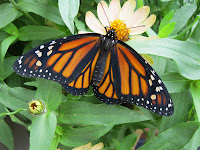 One of things I enjoy, in raising our kids, is reading Eric Carle's "The Very Hungry Caterpillar", over and over again. Such a simple story, decorated with delightful paper mache images. Yet in its simplicity, the book communicates a great message to young and old alike.
One of things I enjoy, in raising our kids, is reading Eric Carle's "The Very Hungry Caterpillar", over and over again. Such a simple story, decorated with delightful paper mache images. Yet in its simplicity, the book communicates a great message to young and old alike. Now that we're on the brink of an impending MN winter, I thought it would be fun to share this warm tale from one of our summer adventures. Enjoy!



"Last summer, we raised our first Monarch butterfly. It was a great experience; with a few failed attempts, we eventually succeeded. Adrian was so excited to see the transformation from a tiny little egg, to eating machine, to shiny green cocoon...and then, finally, a butterfly! The
whole process takes about a month. We find the eggs on the Milkweed plant, which is prolific throughout the countryside by our house.

Once inside the jar with holes atop, we watched the changes take place, day by day. To think that a creature with this kind of design, and intricacies, is deemed to have "evolved", seems ridiculous. Is there anything on earth, quite like the metamorphosis of the butterfly? The caterpillars know that they can eat only milkweed(occasionally, dill weed), making them poisonous to predators.
Having eaten just enough, these little wigglers shed their skin(multiple times), and when they are so full that they can hardly move, they hang upside down, turn themselves inside out, and become like "jelly"--inside the chrysalis. Once inside, all the cells and DNA are programmed to transform this colorful caterpillar into the majestic orange, white and black Monarch butterfly. The name means "King of Butterflies"--and we get to watch it all happen, right here in our own home. So cool.
This past July, we raised two butterflies--Adrian and Samantha's "pets". Our first one hatched on a Monday, after we got home from a short vacation. All was going well until she fell inside her jar. Normally, Monarchs hang from their empty shell for about a day, allowing their wings to dry and fully extend. Something was amiss with this butterfly. We took her out and let her sit out in the sun, on one of my flower pots, for a day. Next day still no change. She couldn't fly away and her wings seem kinda droopy.
I did some research and discovered that butterflies can be infected with a parasite called OE(short for Ophryocystis elektroscirrha). It's spread from the spores on the milkweed plant and can infect future generations of butterflies, especially if you don't sterilize your containers after the fact. Not for sure, but it could be a possibility. If this was the case, our butterfly would not learn to fly, no matter how hard she tried.

I read up on how to feed this poor butterfly and how long we could expect her to survive. It could be several days to weeks, depending on how much care she receives. As directed, I got a small piece of sponge and soaked it in sugar water. This little creature sat on my finger and drank from it's little straw(proboscis), right before my very eyes. It was amazing.
Even though this creature may never grace the blue skies above, the benefit is how close we've been able to get to her: to see her eyes, mouth--watch her eat, stroke her velvety wings. That would've never happened if she were fully developed and had flown away. The last two days, our Monarch friend has been sitting on my vase of flowers, in the kitchen window. This morning, she was glued to the screen, gazing outside as if she knew that was where she belonged.

While it was fun to have our little friend inside the house, I would be leaving on a trip in a few days: so out she had to go. I placed her on my flower pot and she remained there, as happy as a grounded
butterfly could be, until I left town.
Guess what? When I came home, 4 days later, I couldn't find our butterfly. I looked around the plant to see if she had expired, but didn't see a trace of her. A few days later, we were outside and we saw a Monarch fly by, like an airplane, doing take offs and landings--bouncing along.
As it glanced by, I noticed the lower wings were bleached white--suggesting it my have been our little friend. Because we fed her sugar water, her back wings had wicked up some of the moisture--several times--making the orange color fade to white. It was hard to prevent this from happening, and I wondered if that would make it harder for her to survive. Maybe she figured it out, after all!
I continue to be amazed at how great our God is. He wants to reveal Himself to us in big ways and small. The wonder of seeing this creature, up close and personal, was a teachable moment in our lives. Even though I'm mostly unaware of the changes occurring in my life, I have to trust that He is doing a good work in, and through, me. During those times when it feels like nothing new is happening...learning to wait for change to be revealed. In times when I'm so hungry, taking it all in--and being forced to shed my old ways of thinking, relating, parenting, living. One day, we will look in the mirror and see a reflection--recognizable as a "familiar presence", directing our lives. Until we fly away, it's a daily dependence on a Person who's ways are higher than ours."
(reference for my thoughts:2 Corinthians 3:17-18)
